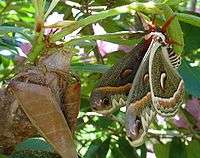Hyalophora cecropia
| Cecropia Moth | |
|---|---|
| | |
| Hyalophora cecropia, mounted adult female | |
 | |
| Living | |
| Scientific classification | |
| Kingdom: | Animalia |
| Phylum: | Arthropoda |
| Class: | Insecta |
| Order: | Lepidoptera |
| Family: | Saturniidae |
| Genus: | Hyalophora |
| Species: | H. cecropia |
| Binomial name | |
| Hyalophora cecropia (Linnaeus, 1758) | |
| Synonyms | |
| |
The Cecropia Moth (Hyalophora cecropia) is North America's largest native moth. It is a member of the Saturniidae family, or giant silk moths. Females with a wingspan of six inches (160 mm) or more have been documented. It is found as far west as the Rocky Mountains and north into the majority of Canadian provinces.[1] The larvae of these moths are most commonly found on maple trees, but they have been known to feed on cherry and birch trees among many others.
Life Cycle

Like all members of the Giant Silk Moth family, the nocturnal adult cecropia moths only reproduce, lacking functional mouthparts or digestive system. Therefore, they survive a maximum of about two weeks.[2]
To find a mate, the female cecropia moth emits pheromones which the male's sensitive antennae can detect up to a mile away, although a male may fly up to 7 miles while searching for a female. Mating begins in the early morning hours and lasts until the evening. Afterward the female lays up to one hundred eggs, which hatch into tiny black caterpillars.
These larvae feed upon many common trees and shrubs, including maple, birch, and apple.[3] As they grow larger, it becomes clear that the black color is actually small black hairs growing from tubercles (small projections) all over the body, which at early stages is yellow-green. As the larvae grow, the coloration becomes green to bluish-green, with the tubercles becoming blue, yellow or orange, depending on body location, while the black hairs are eventually lost. Upon reaching maturity in Autumn, the caterpillars, now 4 to 4.5 inches long, spin large cocoons on trees or wooden structures to emerge as adults in the first two weeks of seasonally warm weather in early Summer. Hyalophora cecropia moths are univoltine, having only one generation per year.
Differentiating between sexes of this species is very easy. The most obvious difference is in the plumose or feathery antennae. Males possess large feathery antennae while females have smaller, less bushy antenna. Females also have larger, more rounded abdomens than males.
Threats
Pests of the moths have become a significant problem. Parasitoids, such as some species of wasps and flies, lay their eggs in or on the young caterpillars. The eggs then hatch into larvae, which consume the internal organs and muscles of the caterpillars. The parasitoid releases chemicals that override the regulatory mechanisms of the caterpillar. Once the parasitoid has grown enough, it induces the caterpillar to pupate. Once the caterpillars pupate, the parasitoid larvae themselves pupate, killing the cecropia pupa. Squirrels also consume the pupae of cecropia moths, which can decrease the populations significantly. Pruning of trees and leaving outdoor lights on at night can also be detrimental to cecropia moths.
In Science
The original description of the insect juvenile hormone by Carrol M. Williams in Nature in 1956 is from the Cecropia silkworm (Platysamia cecropia L.= Hyalophora cecropia) the giant silkworm.[4] This large insect had enough juvenile hormone in its abdomen to permit extraction of detectable JH from a single abdomen.
In the media
In August 2012, a cecropia moth caterpillar was accidentally imported from Ontario to St. John’s, Newfoundland, via a shipment of dogwood shrubs.[5] Cecropia are not native to the latter province.[1] Within 48 hours of its arrival the caterpillar began spinning a cocoon; it wintered at the federal Agriculture and Agri-Food research facility in St. John’s, whence it had been transferred by the owner of the importing company. On 29 May 2013, the predominantly black and red female moth — named ‘Georgina’ by the facility’s staff — emerged from her cocoon boasting a roughly 20 cm wingspan. After allowing Georgina to complete her natural lifespan, researchers planned to pin and preserve her “for future study”.[6]
Life cycle gallery
- Cecropia eggs
- Caterpillar in Toronto
 Caterpillar close-up
Caterpillar close-up Cocoon
Cocoon female pupa
female pupa- Male Adult
- Female Adult
 Adults mating
Adults mating Adult female, close-up
Adult female, close-up Adult male cecropia shortly after eclosion
Adult male cecropia shortly after eclosion
References
- 1 2 Index to the Bombycoidea, Drepanoidea, Lasiocampoidea, and Mimallonoidea of Canada, with regional distributions, Canadian Biodiversity Information Facility, Government of Canada, 2004-02-18, retrieved 2013-06-12
- ↑ Cecropia Moth — Life Cycle
- ↑ Cecropia Moth - Hyalophora cecropia
- ↑ Nature (1956) Vol. 178 No. 4526 Pages 212-213, Carrol M Williams: The Juvenile Hormone of Insects
- ↑ "An uncommon visitor with many little legs". CBC News. 2012-08-08. Retrieved 2013-05-31.
- ↑ "Rare stowaway turns into spectacular moth". CBC News. 2013-05-31. Retrieved 2013-05-31.
External links
| Wikimedia Commons has media related to Hyalophora cecropia. |
| External identifiers for Hyalophora cecropia | |
|---|---|
| Encyclopedia of Life | 385467 |
| Also found in: Wikispecies | |
- Picture journal of cecropia development (warning, it may take a while to load)
- The cecropia moth
- Video presentation of mating Cecropia moths. One had just emerged from and was still on its cocoon: ,
- cecropia moth on the UF / IFAS Featured Creatures Web site